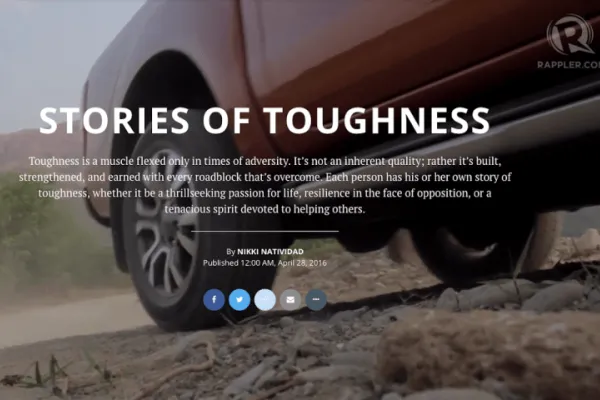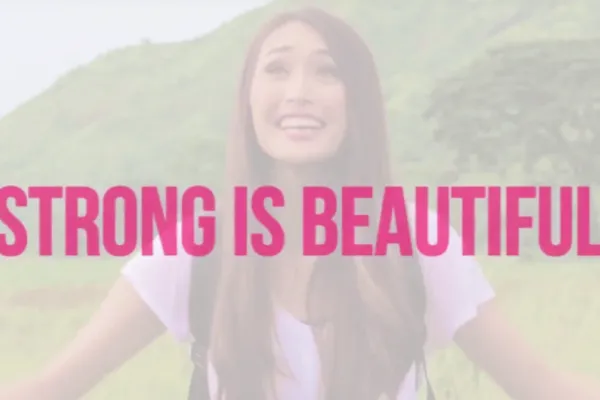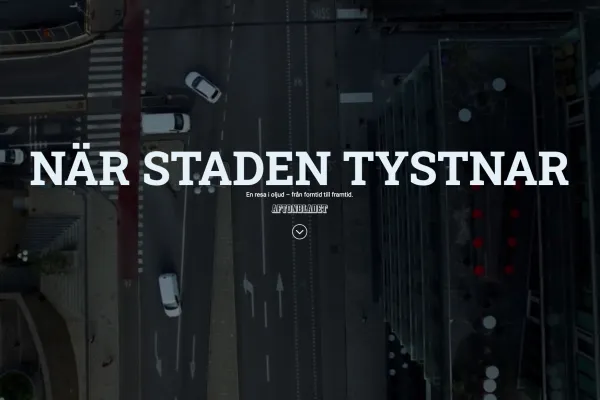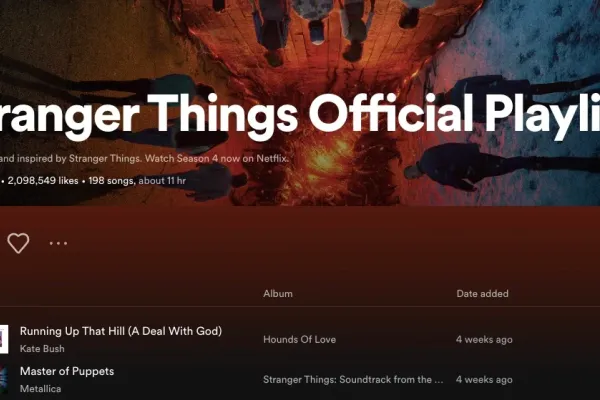
 Details
Details
The world of digital marketing is constantly evolving, and with the rise of ad blockers and banner blindness, traditional forms of advertising are no longer as effective as they once were. This is where native advertising comes in, as it is a form of advertising that blends in with its surrounding content, making it less intrusive and more engaging for the audience.
So now, the question is: What steps can you take to create an effective native advertising campaign of your own?
To get your creative juices flowing, we have compiled a list of eight recent campaigns that really caught our attention. These excellent examples of native advertising may be able to spark the inspiration you need to knock your next campaign out of the park. Let’s dig in.
Spotify and Stranger Things: Monsters and music
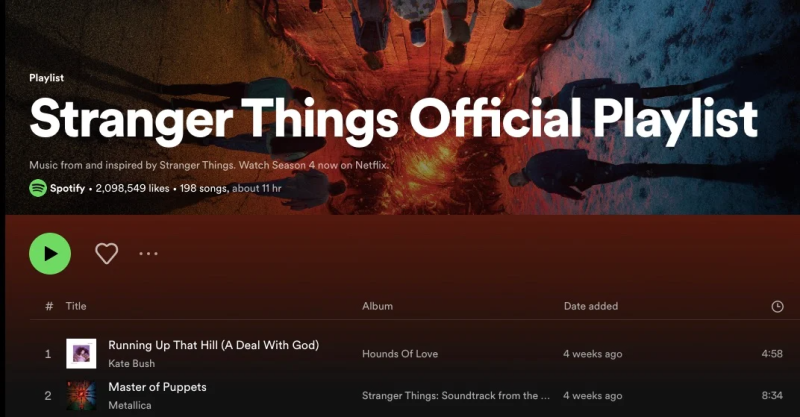
Netflix and Spotify are renowned brands that leverage their users’ data to offer personalised and unparalleled experiences. In 2017, the two giants collaborated to create an outstanding native advertising campaign.
Following the release of the second season of Netflix's hit series Stranger Things, Spotify and Netflix combined forces to give fans of the show a truly unique and immersive experience. Based on their own music history, Spotify users were given a playlist that matched the tastes of one of the 13 show’s main characters - including the Demogorgon.
The two cultural juggernauts teamed up again in 2022 for Season 4, Volume 2, once again offering up both official and custom playlists. Music fans could even discover which of their favourite tunes would save them from Vecna (spoiler alert: in the show, Max is able to escape Vecna by listening to Kate Bush’s “Running up the Hill”.)
This sponsored content was truly a match made in The Upside Down. The look and feel of the Stranger Things universe were flawlessly integrated into Spotify's platform and aesthetic and the partnership felt like a natural extension of the way music was used in the show.
Purina and the Washington Post: Chasing the Promise of Zero-waste Living
Native advertising was the best way to tell the story of photographer, community organiser and van-lifer Noël Russell's sustainable living advocacy and outdoor pursuits with her pets. A partnership between the pet food brand Purina and The Washington Post allowed for seamless integration of Purina’s brand message within the content, making it more effective and less intrusive.
The story is about Purina's commitment to supporting the sustainable lifestyle of people like Russel, who spends time living in a converted van with her husband and their two dogs. The message that comes through is a love for the outdoors and a belief in zero-waste living in order to leave a better planet for future generations. By using native advertising, Purina can showcase its brand values and support for outdoor lifestyles in a video package that is interesting and informative and doesn’t feel like an ad.
Through storytelling, native advertising can capture the reader's attention and create an emotional connection with the brand, making it more likely that they will remember the message and take action. This approach allows Purina to convey its message effectively while supporting a worthwhile cause.
Croatian Lottery: A fun approach to a serious issue
Croatian Lottery's native campaign won the Best Use of Online Media category in the Native Advertising Awards 2022 by taking a serious subject like gambling and making it both engaging and relevant. The campaign aimed to raise awareness among Croatian youth, of whom 13% are believed to have experienced negative consequences due to gambling. It educated them on how to gamble safely and enjoyably.
The campaign started with a survey asking Croatians about their views on gambling. The results were then presented on a microsite designed specifically for the campaign, featuring data and personal stories about the topic. To keep visitors engaged, the campaign featured a range of fun games, ensuring that time-on-page rates remained high while raising awareness about the impact of gambling.
This is a remarkable example of how gamification can be used to educate and engage.
Hyundai, Healthy Seas and BBC Storyworks: An evocative call for a sustainable future
BBC StoryWorks produced an emotional and informative film documenting the clean-up of an abandoned fish farm in the waters surrounding Ithaca, Greece.
The farm was wreaking havoc on the environment and the livelihoods of local fishermen. The ‘ghost gear’ – lost, abandoned or discarded fishing nets, cages and traps – are made from durable Nylon 6 plastic yarn and can take decades to break down and travel vast distances upon ocean currents. All the while, the gear does what it’s designed to do – catch and kill marine life.
The documentary focused mainly on the work of the NGO Healthy Seas, linking its environmental goals with Hyundai's commitment to developing a circular economy.
Hyundai's dedication to social responsibility is woven throughout the film, which closes on a global call to fight for a sustainable future while showcasing Hyundai's use of ghost gear in its products.
“That strikes me as a really, really good example of what native advertising, branded content is at its best,” Richard Pattison, Senior Vice President, BBC StoryWorks, previously told the Institute. “It's a brand really genuinely making a difference and then they're using the waste material in their interiors as well.”
The native advertising format allowed Hyundai to tell this longer and more complex story and create a partnership with its customers.
→ RELATED: A tale of two campaigns: It was the best of ads, it was the worst of ads
Aftonbladet and various brands: Building a buzz among young viewers
To engage with younger audiences, Sweden's top media house, Aftonbladet, tapped a young employee Mauri Hermundsson. Using Hermundsson’s YouTube skills and charming personality, Aftonbladet launched the popular video series ‘Uppdrag: Mat’ (Mission: Food), which has published 70+ videos and racked up a cumulative 136 million views and counting.
Advertisers capitalise on Hermundsson's brand by linking their messages to the popular channel, reaching over one million viewers per episode on average. ‘Mission: Food’ primarily uses YouTube to target its preferred audience, but some episodes are also featured on Aftonbladet's homepage. The show was also part of the launch of Schibsted's new food-focused channel, Godare, in 2021.
‘Mission: Food’ enjoys organic views from a target audience that actively engages with the content. Videos include such titles as “A day in the life of Sweden’s most spoiled person” and “Trying to eat like Sweden’s strongest man for a day”.
The ‘Mission: Food’ channel, which has around 620,000 subscribers, sold out of sponsor placements in 2022 and has built up such a rabid following that he wildly popular musician and songwriter Ed Sheeran's management requested a guest appearance on one of the episodes. Sales of featured brands increased by 227 percent between 2019 and 2020, and another 69 percent between 2020 and 2021. They continued to rise in 2022 compared to 2021. The content process exemplifies true branded content, with clear boundaries on advertiser mentions, limited to one per episode for a maximum of 60 seconds.
Audemars Piguet and Morning Studio: A breathtaking use of infographics
An art installation entitled ‘The Moon Is Leaving Us’ was created by Hong Kong-based artist Phoebe Hui and showcased as part of the fifth Audemars Piguet Art Commission in Asia in 2021.
To promote the event, Morning Studio produced an immersive online experience with editorial storytelling, photos, and illustrations organised into six chapters, each featuring striking graphics. The multimedia format showcased the art, science, and poetry that inspired Hui's installation, taking readers on a virtual journey to the moon before inviting them to experience the artwork in person at Tai Kwun.
The campaign used a fully online-to-offline approach. The multimedia page was posted on the studio's website and on the South China Morning Post, attracting organic traffic to the story. The campaign was also promoted on the studio's Facebook and Instagram profiles. To complement the digital execution, a custom 32-page, bilingual print booklet titled "Lunar Effect” guided physical event-goers through the exhibition. Despite being a hybrid virtual and limited in-person experience due to COVID-19, the event was a massive success.
In 30 days, the campaign reached over 321,631 users in total, 2,500 percent over the target. Meanwhile, the studio’s website received 84,895 page views during the campaign period. Distribution across multiple channels got over 3.6 million impressions, 80 percent over target.
The success of ‘The Moon Is Leaving Us,’ shows clearly that using thoughtful and functional yet impressive graphic art to create dynamic and immersive experiences is an excellent way to tell a story that will resonate with the audience.
BuzzFeed and Walmart: Simple but effective
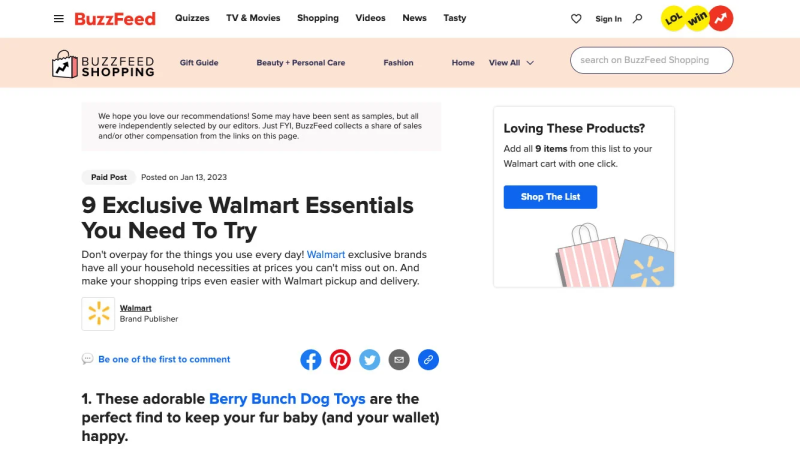
Often, depending on the audience, the simple approach is the best approach.
The BuzzFeed/Walmart combo ‘9 Exclusive Walmart Essentials You Need To Try’ is simple, to the point and drives what Walmart wants: more people considering (and buying) from its online store.
It is a great example of the kind of content that resonates with Walmart’s target audience of low to middle-class rural families. Price and discounts are something they look for. In the digital marketplace, Walmart has succeeded in establishing a strong brand based on trust through its effective marketing strategy. The company's ability to instil confidence in its consumers when making purchases sets it apart from its competitors. The ‘exclusive essentials’ angle of WalMart’s content fits seamlessly into the BuzzFeed environment.
Buzzfeed is a well-known innovator in viral content and has an enormous young audience – one in two US internet users between the ages of 18 and 34 interact with the site on a monthly basis. The Walmart listicle is just one of the many sponsored collaborations the site offers through its Buzzfeed Shopping subsite. It's a combination between traditional affiliate marketing and the types of shareable lists the site is known for.
Salesforce and The Atlantic: Powering tomorrow's leaders
Native advertising offers a significant advantage by allowing brands to tell a more meaningful story that resonates with their target audience. Recently, Salesforce.org partnered with The Atlantic’s Re:Think to create a short article and a remarkable native video that delves into the legacy of the first Boys & Girls Club for black children.
This 5-minute and 29-second video provides a glimpse into the club's history, its impact on the community, and how Salesforce technology has helped streamline operations. It is an excellent example of the power of native advertising, which can create an emotional and compelling experience for the audience.
Takeaway
These are just a few examples of why native advertising has emerged as the most effective advertising strategy in today's digital landscape. As seen above, native ads are often presented in the form of sponsored content, which implies a level of endorsement from the publisher. This endorsement can increase the credibility of the ad and improve the user's perception of the brand.
Native advertising also allows for improved targeting, as ads can be customised to fit the user's interests and preferences. This customization results in higher conversion rates as users are more likely to engage with ads that are relevant to them.
Overall, businesses that incorporate native advertising into their marketing strategy are more likely to see success in today's digital ecosystem due to its ability to provide a better user experience, increased engagement, higher credibility, improved targeting and better return on investment.
